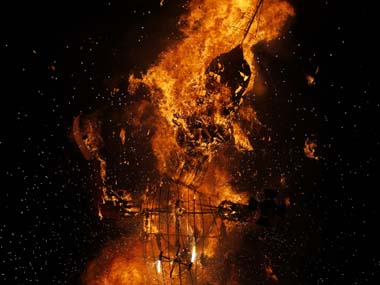This evening, on Vijayadashami day, across large parts of north India, flaming arrows will fly through the air and set fire to giant mannequins. It is a symbolic enactment of the slaying by the mythological warrior-king Rama, of Ravana, the demon king who epitomises all that is evil. The annual ritual of the bonfire of vanities symbolises the belief, the feeble hope, that the evil that walks this land will be overcome by the force for good and lead to good governance, as it did during the period of ‘Ram rajya’ – Rama’s reign. In other parts of India, and across other cultures, too, much the same theme – of good triumphing over evil – is played out every year on this day. [caption id=“attachment_501147” align=“alignleft” width=“380”]  If the ten heads of Ravana symbolically represented 10 “evil” qualities that we seek to vanquish, then the evil that Ravana epitomised continues to thrive in today’s India. Reuters[/caption] But is our collective faith in the supremacy of good validated by our lived experiences? Or do our myriad daily experiences cause us to question the validity of that faith virtually every day of every year? More fundamentally, do we even have the capacity to distinguish between good and evil? If one were to feel the average Indian’s pulse today, one would perhaps get the sense that there is widespread angst that as a nation and as a people we are on a downward spiral, and that things are getting worse – in virtually every sphere that matters. If the ten heads of Ravana (the demon king who is ritually set on fire tonight) symbolically represented 10 “evil” qualities that we seek to vanquish, then the evil that Ravana epitomised continues to thrive in today’s India. Indicatively, Lobha (greed), the value associated with one of his ten heads, manifests itself in the succession of corruption scandals – by leaders across the political spectrum, and by corporates that corner national resources on the cheap, and by bureaucrats who grease the tracks – and in countless transactions that we go through on a daily basis. Likewise, in public life as well as in our private lives, there’s plenty of Krodha (anger) , Moha (delusion), Mada (excessive pride) and Ahankara (ego), to name just a few of the other qualities that Ravana’s heads are associated with. We’re a long way from ‘Ram rajya’, which was portrayed in mythological texts as having been characterised by righteousness and dharma, and where the compassionate ruler looks out for his subjects and is responsiveness to their every need. Just as important, ‘Ram rajya’ was characterised by a high standard of governance and the accountability of rulers: when slanderous allegations were made against his wife Sita, Rama did not airily dismiss them in the way that today’s party leaders and politicians — again across the political spectrum — do when grave allegations of wrongdoing are made against them or their sons-in-law. Instead, Rama forced Sita to undergo ‘trial by fire’ so as to convincingly dispel the slander. In modern-day terms, it is the equivalent of subjecting oneself (and one’s relatives) to an investigation by a Special Investigation Team (SIT) to decisively clear the air when grave allegations are made. That the UPA government, which as Subramanian Swamy said derisively only believes in ‘Rome Rajya’, does not abide by the high standards of governance that prevailed under ‘Ram rajya’ (as narrated in the epic texts) isn’t entirely surprising. What is, however, disappointing is that the BJP, which once promised us ‘Ram rajya’, should also fall at the hurdle of good governance that characterised that mythological era. Barring notable exceptions, today, most States where the BJP has been in power are far from shining examples of good governance, and the corruption there has meant that the party is pretty indistinguishable from the Congress. Sadly, when it did promise ‘Ram rajya’, the BJP took it a little too literally, with its campaign for a Ram temple at Ayodhya, where the Babri Masjid stood and which in the belief of the faithful, is considered the birthplace of Rama. As a political mobilisation exercise, it may have been successful in the short term, but it also branded the party as divisive, a legacy that continues to haunt it today. In fact, the real significance of ‘Ram rajya’ lies in the promise of the highest, noblest form of governance. The real ‘temple’ that needs to be built is this blessed nation that is aching for good governance – and the chance to realise its potential. It’s the real ‘Ram rajya’ that India needs; but our benighted parties are too busy throwing flaming arrows at each other to offer us Dussehra day spectacles all the year round.
The real significance of ‘Ram rajya’ lies in the promise of the highest, noblest form of governance. Sadly, no party - not even the BJP - is ready to deliver on that promise.
Venky Vembu attained his first Fifteen Minutes of Fame in 1984, on the threshold of his career, when paparazzi pictures of him with Maneka Gandhi were splashed in the world media under the mischievous tag ‘International Affairs’. But that’s a story he’s saving up for his memoirs… Over 25 years, Venky worked in The Indian Express, Frontline newsmagazine, Outlook Money and DNA, before joining FirstPost ahead of its launch. Additionally, he has been published, at various times, in, among other publications, The Times of India, Hindustan Times, Outlook, and Outlook Traveller. see more


)

)
)
)
)
)
)
)
)



